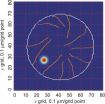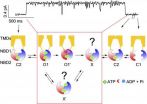(Press-News.org) MANHATTAN, Kan. -- Researchers at Kansas State University have developed a simple blood test that can accurately detect the beginning stages of cancer.
In less than an hour, the test can detect breast cancer and non-small cell lung cancer -- the most common type of lung cancer -- before symptoms like coughing and weight loss start. The researchers anticipate testing for the early stages of pancreatic cancer shortly.
The test was developed by Stefan Bossmann, professor of chemistry, and Deryl Troyer, professor of anatomy and physiology. Both are also researchers affiliated with Kansas State University's Johnson Cancer Research Center and the University of Kansas Cancer Center. Gary Gadbury, professor of statistics at Kansas State University, helped analyze the data from tests with lung and breast cancer patients. The results, data and analysis were recently submitted to the Kansas Bio Authority for accelerated testing.
"We see this as the first step into a new arena of investigation that could eventually lead to improved early detection of human cancers," Troyer said. "Right now the people who could benefit the most are those classified as at-risk for cancer, such as heavy smokers and people who have a family history of cancer. The idea is these at-risk groups could go to their physician's office quarterly or once a year, take an easy-to-do, noninvasive test, and be told early on whether cancer has possibly developed."
The researchers say the test would be repeated a short time later. If cancer is confirmed, diagnostic imaging could begin that would otherwise not be routinely pursued.
According to the American Cancer Society, an estimated 39,920 breast cancer deaths and 160,340 lung cancer deaths are expected in the U.S. in 2012.
With the exception of breast cancer, most types of cancer can be categorized in four stages based on tumor growth and the spread of cancer cells throughout the body. Breast and lung cancer are typically found and diagnosed in stage 2, the stage when people often begin exhibiting symptoms such as pain, fatigue and coughing. Numerous studies show that the earlier cancer is detected, the greater chance a person has against the disease.
"The problem, though, is that nobody knows they're in stage 1," Bossmann said. "There is often not a red flag to warn that something is wrong. Meanwhile, the person is losing critical time."
The test developed by Kansas State University's Bossmann and Troyer works by detecting increased enzyme activity in the body. Iron nanoparticles coated with amino acids and a dye are introduced to small amounts of blood or urine from a patient. The amino acids and dye interact with enzymes in the patient's urine or blood sample. Each type of cancer produces a specific enzyme pattern, or signature, that can be identified by doctors.
"These enzyme patterns can also help distinguish between cancer and an infection or other diseases that commonly occur in the human body," Bossmann said. "For example, a person who smokes a lot of cigars may develop an inflammation in their lungs. That will drive up some of the markers in the test but not all of them. Doctors will be able to see whether there was too much smoke inhalation or if there is something more serious going on. False-positives are something that we really want to avoid."
Once the test is administered, comprehensive results -- which include enzyme patterns -- are produced in roughly 60 minutes.
Bossmann and Troyer have designed a second testing method that is anticipated to produce the same results in about five minutes. The team recently received $305,000 in funding for this project from the National Science Foundation's Division of Chemical, Bioengineering, Environmental and Transport Systems.
In addition to early detection, researchers say the test can be tweaked to monitor cancer. For example, patients being treated with drugs can be observed for drug effectiveness. Similarly, doctors can use the dye in the test to determine if the entirety of a tumor has been successfully removed from a patient after surgery.
Researchers evaluated the test's accuracy on 32 separate participants in various stages of breast or lung cancer. Data was collected from 20 people with breast cancer -- ranging in age from 36 to 81 years old -- and 12 people with lung cancer -- ranging in age from 27 to 63 years old.
Twelve people without cancer were also tested as a control group. This group ranged in age from 26 to 62 years old.
A blood sample from each participant was tested three times. Analysis of the data showed a 95 percent success rate in detecting cancer in participants, including those with breast cancer in stages 0 and 1 and those with lung cancer in stages 1 and 2.
Tests detecting for pancreatic cancer are anticipated to begin in October as part of Bossmann and Troyer's collaboration with Dr. Stephen Williamson at the University of Kansas Medical Center. Blood samples from triple-negative breast cancer patients will be tested this fall in collaboration with Dr. Priyanka Sharma, who is also at the University of Kansas Medical Center.
### Funding for the study -- titled "Functionalized Bimagnetic Core/Shell Fe/FE3O4 Stealth Nanoparticles for Diag & Treatment Cancer" -- was originally provided through a subcontract of a National Institutes of Health phase II Small Business Innovation Research grant to NanoScale Corp., a Manhattan-based company that manufactures, markets and commercializes advanced products and technologies, and by the Johnson Cancer Rsearch Center at Kansas State University. A Small Business Innovation Research grant is awarded to small businesses with a university partner for the purpose of accelerating research to enter the commercial marketplace.
Researchers develop blood test that accurately detects early stages of lung, breast cancer in humans
2012-09-26
ELSE PRESS RELEASES FROM THIS DATE:
A birth control pill for men? When?
2012-09-26
When will men have their own birth control pill? Scientists have been predicting the debut of a male pill within 5 years for the last 30 years. The factors accounting for that delay — and new optimism that a male pill will emerge within a decade — are the topic of a story in the current edition of Chemical & Engineering News. C&EN is the weekly newsmagazine of the American Chemical Society, the world's largest scientific society.
In the story, Michael M. Torrice, C&EN associate editor, describes the need for a male version of the oral contraceptive pill that revolutionized ...
Loss of species makes nature more sensitive to climate change
2012-09-26
High biodiversity acts as an insurance policy for nature and society alike as it increases the likelihood that at least some species will be sufficiently resilient to sustain important functions such as water purification and crop pollination in a changing environment.
"It's the same principle as an investment portfolio – you'd be mad to put all your eggs in one basket," says researcher Johan Eklöf.
Experiments with eelgrass meadows in shallow inlets on the west coast of Sweden are now showing that climate change can exacerbate the negative effects of losing sensitive ...
Geometry plays a role in GPCR transmembrane signaling
2012-09-26
A recent study in The Journal of General Physiology characterizes the movement of rhodopsin, a GPCR and member of a large family of transmembrane receptors responsible for many cellular responses and involved in many human diseases.
In living Xenopus rod photoreceptor cells, rhodopsin is found in stacks of disc membranes that are difficult to study due to their small size. Now, Peter Calvert (SUNY Upstate Medical University) and colleagues have developed an approach with two-photon microscopy that, for the first time, allows direct examination within the living cell ...
University of Kentucky research sheds light on pain pill abuse
2012-09-26
LEXINGTON, Ky. (Sept. 26, 2012) — A study by a team of University of Kentucky researchers has shed new light on the potential habit-forming properties of the popular pain medication tramadol, in research funded by the National Institute on Drug Abuse. The paper is slated to appear in an upcoming edition of the academic journal Psychopharmacology.
Prescription pain killer abuse is a major public health problem in the U.S. In 2010, more individuals over the age of 12 reported nonmedical use of prescription pain relievers in the past month than use of cocaine, methamphetamine ...
New insights into functionality of cystic fibrosis protein
2012-09-26
CFTR is an important protein that, when mutated, causes the life-threatening genetic disease cystic fibrosis. A study in The Journal of General Physiology (JGP) details how an accidental discovery has provided new understanding about CFTR functionality.
From a scientific standpoint, CFTR is unique in that it is the only known ion channel—a protein pore that enables the passive diffusion of ions across cell membranes—in the enormous superfamily of ABC proteins, which normally operate as active transporters. As active transporters, ABC proteins use energy derived from ...
Paper: Federal law needed to safeguard 'digital afterlives'
2012-09-26
CHAMPAIGN, Ill. – Federal law ought to play a stronger role in regulating social networking sites by allowing users to determine what happens to their "digital afterlives," says a recently published paper by a University of Illinois expert in intellectual property law.
Allowing social networking sites to set their own policies regarding the content associated with the accounts of deceased users does not adequately protect individual and collective interests, especially with people spending an increasing part of their lives online using social networking sites, says Jason ...
Duke Medicine news -- Protein structure unlocks 1 mystery of multi-drug tolerance
2012-09-26
DURHAM, N.C. – The structures of key bacterial proteins have revealed one of the biochemical secrets that enables bacteria to outwit antibiotics.
In a paper published Sept. 20, 2012 in the journal Cell Reports, Duke University School of Medicine researchers and their colleagues describe the results of a series of experiments exploring multi-drug tolerance, a phenomenon that allows bacteria to become dormant and tolerate antibiotics, only to later awaken and re-infect the host. Drug tolerance is a factor in several types of stubborn, recurring infectious diseases caused ...
Taking the battle against the toxic trio beyond 'Leaves of 3, leave it be'
2012-09-26
With more than half of all adults allergic to poison ivy, oak and sumac, scientists are reporting an advance toward an inexpensive spray that could reveal the presence of the rash-causing toxic oil on the skin, clothing, garden tools, and even the family cat or dog. Using the spray, described in ACS' The Journal of Organic Chemistry would enable people to wash off the oil, or avoid further contact, in time to sidestep days of misery.
Rebecca Braslau and colleagues explain that allergic reactions to oils of the toxic trio are more than a nusiance. They claim a huge human ...
Bigger wind turbines make greener electricity
2012-09-26
WASHINGTON, Sept. 26, 2012 — The latest episode in the American Chemical Society's (ACS') award-winning Global Challenges/Chemistry Solutions podcast series concludes that the larger the wind turbine, the greener the electricity it produces. The study could solidify the trend toward construction of gigantic windmills.
Based on a report by Marloes Caduff in ACS' journal Environmental Science & Technology, the new podcast is available without charge at iTunes and from www.acs.org/globalchallenges.
In the new episode, Caduff, a graduate student, and Stefanie Hellweg, ...
Exposure to snot-nosed kids ups severity of cold infections
2012-09-26
Exposure to school-age children raises the odds that a person with lung disease who catches a cold will actually suffer symptoms like a runny nose, sore throat and cough, according to a study just published in the Journal of Clinical Virology.
That finding, the result of a study that drew upon a databank of 1,000 samples of sputum and nasal secretions from people with chronic obstructive pulmonary disease or COPD, comes as a surprise, says Ann Falsey, M.D., professor of Medicine at the University of Rochester and an infectious disease expert at Rochester General Hospital. ...


